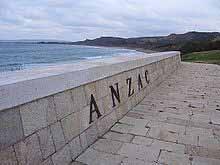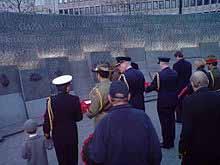
4 minute read
Anzac Day
Members of The Royal Green Jackets Association, Australasian Branch, have taken part in the celebrations and official March commemorating the anniversary of Anzac Day since 2002. The parade through the city of Perth in Western Australia is mirrored in every City of Australia on April 25th every year. Approximately 8000 serving and ex serving soldiers, sailors and airmen take part in the parade in Perth, watched by approximately 30,000 people, lining the streets, plus those watching on television. However some Association members have since asked the question “what is Anzac day?” Ken Ambrose has asked me to put something together to let the Association know what this Anzac Day thing is all about. Anzac Day-April 25th is Australia’s most important national occasion. It is also a national Day off. It has been considered by various Australian federal Government’s to shift “Australia day” (normally January 26th) to be commemorated on Anzac Day. The Origins It marks the anniversary of Australia’s first military action during World War1. Anzac stands for Australian and New Zealand Army Corps, the soldiers serving in this Corps were known as Anzac’s. In 1914 when war broke out, Australia was under a federal Government that had been created only 14 years earlier and was eager to establish itself amongst the Worlds nations. In 1915, the Anzac’s formed part of the allied expeditionary force that was tasked with securing the Gallipoli peninsula to assist in opening the Black Sea to the allied naval force. The plan was to capture Constantinople (now Istanbul), which at the time was Capital of the Ottoman Empire, one of Germany’s allies. The Anzac’s landed at a Cove (later known as Anzac Cove) in Gallipoli on April 25th 1915, in attempting to storm the peninsula the Anzac’s met fierce opposition from Turkish defenders that resulted in an eight month long stalemate and 8000 Australian and New Zealand soldiers losing their lives. In keeping with a perceived Victorian and Edwardian “rite of passage” The Anzac’s had conformed to a “blood sacrifice” in an initiation as a birth of a nation. Commemorative marches took place in most Australian Cities after 1916, where returned serviceman marched to commemorate the lives lost on the Gallipoli Peninsula. In 1921 an act of the Federal Government of Australia secured April 25th as a National day of remembrance and a public holiday, however marches did not take place in all Cities until 1927. In 1942 marches were actually cancelled, as the threat of air invasion by the Japanese was considered too high. Since the 1930’s the Anzac day public holiday has been associated with the Banning of public horse races, Dawn vigils at War Memorial’s, Marches, memorial services and prayers, reunions, “two-up games” (gambling, where bets are placed on the tossing of a coin) and Police throughout Australia turning a blind eye to the consumption of alcohol in the street outside pubs. Since the end of World War II, Anzac Day has figured prominently around Australia and New Zealand as a National day of commemoration for both Countries to the lives lost at Gallipoli and all other conflicts since World War II that Australia has taken part in and lost lives. Dawn services and elaborate ceremonies incorporating rifle and cannon volleys, pipers, readings and hymns take place in All Capital Cities and most country towns throughout both Countries, attracting tens of thousands of people who stand in quiet reflection as thousands of serving and exserving returned serviceman march through the cities usually to a large public area where a service is conducted incorporating eulogies and prayers to the fallen, which serves as reminder to the youth of both Countries, of the sacrifices made and the lessons to be learnt from the many different meanings of war. The Dawn services held throughout both Nations are derived from the practices of operational morning routine exercised by British, Australian and New Zealand Armies. To reduce the confusion of soldiers caused by the half-light of dawn, soldiers have been traditionally roused half an hour before dawn, to ensure that as the morning light slowly grew brighter from the dull grey of dawn, that soldiers would be awake, alert and manning their weapons. To soldiers the world over this is known as “Stand To” and is repeated at sunset. During the dawn services, wreaths are laid and a two- minute silence is maintained to reflect on fallen comrades, preceded by the “last post” and followed by reveille played usually by a Bugler. Chris McDonald Chairman Australasian Branch RGJRA The Internet Branch – Its purpose What is AN ZAC Day? - BY CHRIS MC DONA LD Members of the Australasian Branch, RGJRA on 25 April 2010 at the Anzac Parade in Perth, Western Australia Anzac Day-April 25th is Australia’s most important national occasion. It is also a national Day off. It has been considered by various Australian federal Government’s to shift “Australia day” (normally January 26th) to be commemorated on Anzac Day. Anzac Cove, Gallipoli The wreath laying at the 2008 dawn service at the Australian War Memorial at Hyde Park Corner, London The Last Post is played at an
Anzac Day ceremony.
Advertisement





